HP EliteBook 8570w Notebook Review: The Other Side of the Coin
by Dustin Sklavos on December 18, 2012 12:01 AM EST- Posted in
- Laptops
- Systems
- AMD
- HP
- Mobile Workstation
- Ivy Bridge
- GCN
- FirePro
Display Quality
The HP EliteBook 8570w is capable of being outfitted with a 10-bit IPS display that HP dubs DreamColor, and the high color gamut can be a sight to behold. On top of that, we're looking at a 1920x1080 display in a 15.6" form factor, a pixel density much appreciated in notebooks. It appears that LG Philips is manufacturing the majority of these high end panels that are being used, as Dell's Precision M6700's PremierColor display is also using one of their panels.
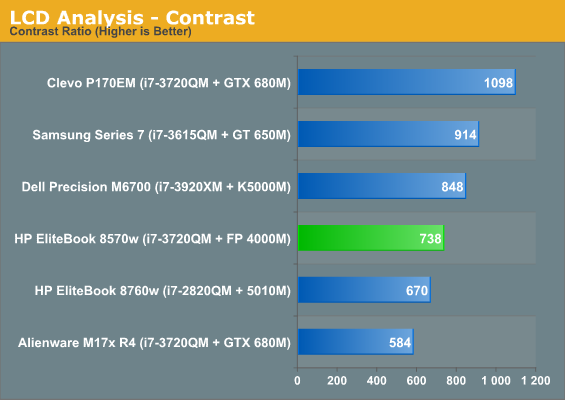
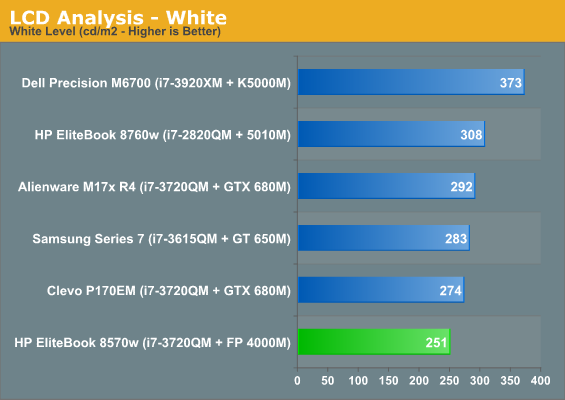
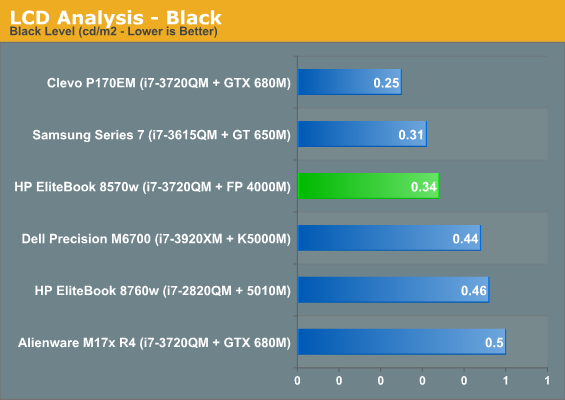
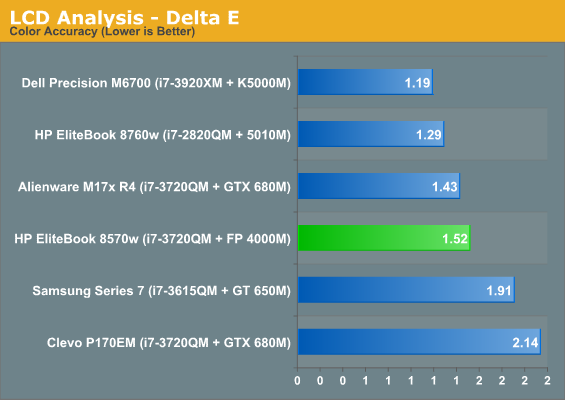
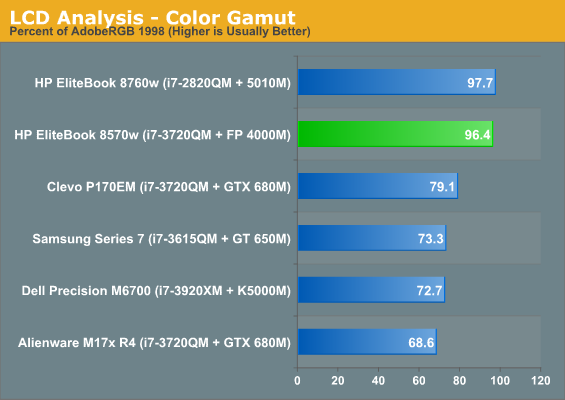
The 8570w's display isn't particularly bright, but it's bright enough, and the colors are incredibly vibrant and crisp. Note that we had to calibrate the M6700's display at a gamma of 1.8 instead of our typical 2.2, and its test results do suffer as a result. I'd argue that, size notwithstanding, the M6700's display quality is actually comparable, and you benefit from their PremierColor software which allows for changing color gamut on the fly.
You can see, though, the 8570w is able to produce almost the entirety of the AdobeRGB 1998 color gamut, with fine contrast and good (though not exceptional) color accuracy.
Battery Life
As many of you pointed out in the last review, the use of a 10-bit IPS panel precludes any kind of switching graphics technology. The result is a notebook that takes a substantial hit to running time. Unfortunately, that hit is exceptionally evident with the HP EliteBook 8570w.
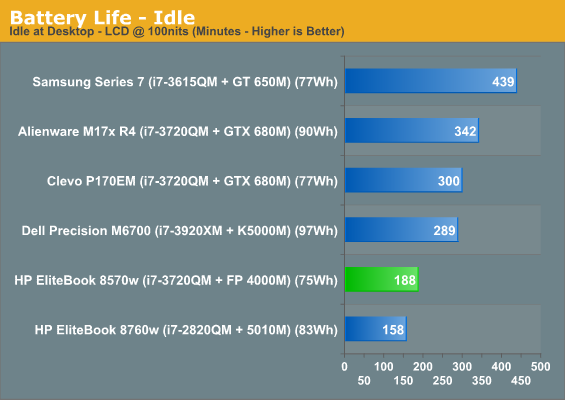

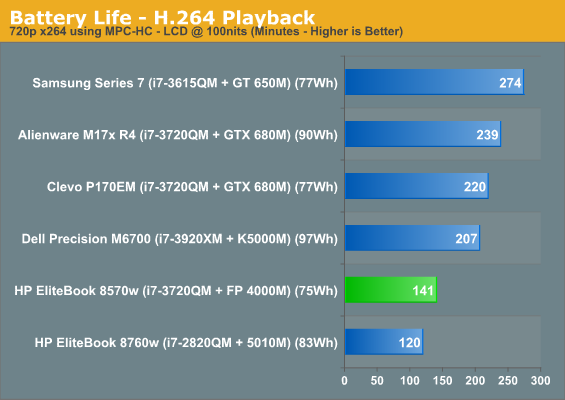
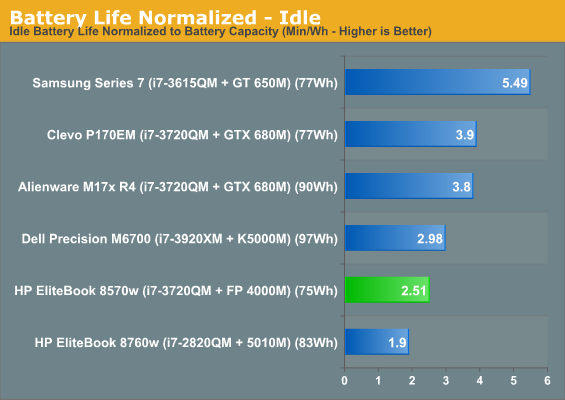


As you can see, you're just not going to be using the 8570w on the battery that often. Even the normalized results are pretty poor, inexplicably ranking below the results of the larger Dell Precision M6700 despite that notebook's larger display and hotter CPU and GPU. In this day and age, a useful running time below three hours is almost inexcusable.
Heat and Noise
You remember how I mentioned that heat was the primary weakness of the HP EliteBook 8570w's design? It's finally time to check in on it, and as you'll see, it's not a happy picture.

While the FirePro M4000 doesn't heat up that much (and shouldn't, really), the i7-3720QM's cores encroach on the high 90s, just too high for comfort. When we opened up the bottom of the 8570w, you saw how modest the cooling system design was, and now you see how that plays out. Because of the high temperatures, the 8570w is also capable of producing quite a bit of fan noise. At idle, the fan is almost constantly spinning, albeit quietly. Under sustained load, it begins to develop a high-pitched fan whine and becomes increasingly audible, easily peaking above 40dB.
The CPU itself actually overheats a little and starts to throttle. Under AIDA64's stress test, the CPU throttled by as much as 14% after just five minutes. It's no surprise HP elected not to offer the 55W Ivy Bridge quads in the 8570w; the notebook can barely handle 45W.











54 Comments
View All Comments
Kevin G - Tuesday, December 18, 2012 - link
There is little difference between the drivers on consumer level GPU's under OS X and the workstation class video card drivers under Windows. That is the key difference between workstation and consumer level GPU's: drivers. Take a look at the cross platform software and the software vendors do certify the OS X drivers.Beyond that the other differences between consumer and workstation GPU's are often related to GPU compute. nVidia only offers full speed GPU compute on their Telsa cards and have even started to nerf the Quadro line up (though not as much as Geforce cards based upon the same GPU die).
I've been able to spot two other minor differences between consumer and workstation cards. The first is hardware based line anti-aliasing and 10 bit color support. Under OS X, both this AA technique and 10 bit color output are provided on consumer cards.
The last difference would be the cards themselves. Workstation cards due tend to have additional outputs (either DL-DVI or DP) and more on board memory for the GPU. For a laptop this isn't as critical but worth noting for desktop systems.
ananduser - Tuesday, December 18, 2012 - link
You can add the fact that Win under bootcamp runs relatively poor compared to a native machine. You lose a good 25%(at least) on battery life and no optimus-type switching. The drivers are also generic and have an impact on the system's overall IOPS(due to drivers). All in all not a good machine at all. It's good for the Apple user that needs sporadic native windows access on his machine and that's just about it.damianrobertjones - Tuesday, December 18, 2012 - link
Please mention that you can purchase an extended BB09, CC09 or SR09 battery for this device. BB09 and CC09 providing the most battery life.damianrobertjones - Tuesday, December 18, 2012 - link
P.s. Anyone planning on buying should really consider re-applying the thermal compound as the basic application isn't the best in the world.Flunk - Tuesday, December 18, 2012 - link
That is true of every notebook I've ever seen.ijozic - Tuesday, December 18, 2012 - link
Just two points worthy of mention regarding the Dell..First, it was first offered with the IPS screen, as well, but most (if not all?) were plagued by blue tint issues so they are no longer offered (I'm surprised if the HP doesn't have the same problem as I'd presume the screens are pretty much the same?). So, if a better stock of displays is obtained, they might be offered again.
Second, it seems to have a much better cooling system as it also offers the XM CPUs.
Oskars Apša - Tuesday, December 18, 2012 - link
Why not review workstations with 3D models and drawings that are made by some interior and graphics designers, even architects?I as a designer would see value if you had benchmarked programs like AutoCad, 3DS MAX and Corel draw with real life models, scenes and drawings.
I don't see value in primitive benchmarking that is made upon models that ar made by some benchmark "manufacturer". That might be good for game designers at most.
Also, screens of benchmarked 3D and other objects are a must.
lx686x - Tuesday, December 18, 2012 - link
SPECviewperf is pretty much a standard for workstation class GPU's so I don't see a problem here.You need a benchamrk not some random scenes.
Oskars Apša - Tuesday, December 18, 2012 - link
I disagree. By look the SPEC provided models and scenes look like random leftover highscool projects. Models are primitive texture vise and the same can be said about models themselves.The only good models are provided for Siemens, but that isn't the most used program by designers, or is it?
A standart made by some company for 6 year old console game development doesn't mean it is sufficient.
lx686x - Tuesday, December 18, 2012 - link
It doesn't matter, if it scores lower in SPEC in will also have lower FPS in real programs as well.If you know any other BENCHMARK then suggest it...